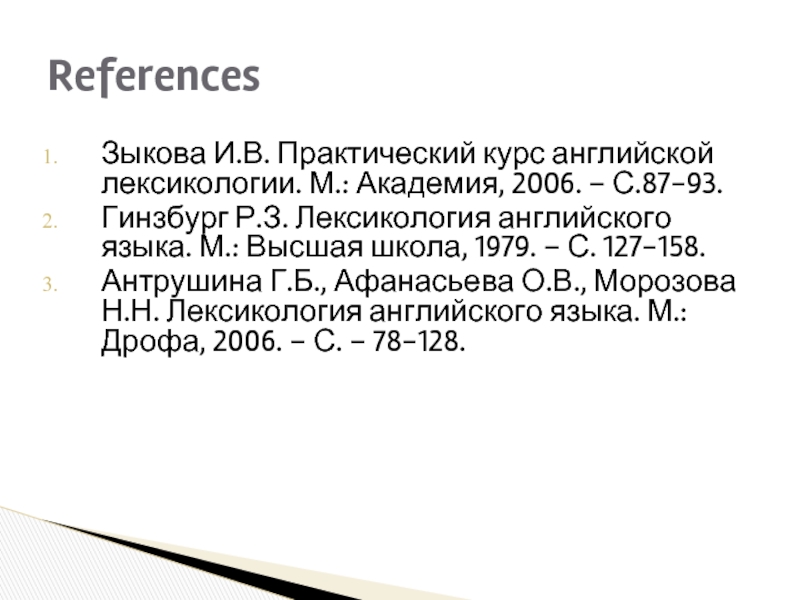
By Jacqueline Schaalje
In English, as in many other languages, you can make new words by combining two words.
Here are some examples:
1 lighthouse – made from light and house
A lighthouse is the tower with a strong lamp on top that warns ships to stay off the coast.
But a light colour is not a compound word. Here, light just means that the colour is closer to white than to black.
Light can also mean not heavy.
Lightweight is a compound word. A lightweight is someone who doesn’t weigh a lot. This term is used in sports such as boxing, judo or weightlifting where it matters how heavy you are. There is also middleweight and heavyweight.
But a light meal is not a compound word. A meal can also be heavy or healthy, etc.
2 Software is a compound word. They are the programs that your computer or phone uses.
But soft wool is not a compound word.
3 Hothouse is a compound word. It’s the building, often made of glass, in which plants grow in an artificially environment. Usually the glass house is hotter than the weather outside, so that’s how it got its name.
But a house can also be hot or cold, so a hot house it’s not a compound word.
4 Fruitcake is a compound word. It’s a cake made with fruits. But you can also say this to someone who is mad.
Fruit tree is also a compound word. It’s a tree that bears fruit.
But a large tree is clearly not a compound word. Trees can also be small, wide, green, etc.
5 Blackbird is a compound word. It’s a common black bird with a yellow beak which sings beautifully.
A black bird is not a compound. It’s just a bird that’s black. But it could also be purple.
What Stress Tells You about Compound Words
Note: In compounds, the stress is most usually on the first word. So in blackbird, the stress is on “black.”
Whereas, if it’s not a compound word, the stress is most often on the second word in the compound. So, in “black bird,” which is not a compound, the stress would be on “bird.”
6 A darkroom is a room that is kept dark (no light), for instance to develop photographs. It can also be a room without light in a bar or club, in which case it is meant for anonymous sexual activities.
A dark room is not a compound. It could be a room in which the windows are small or even without windows at all.
7 A sunflower is a large yellow flower that is grown for its seeds. Its head turns into the direction of the sun.
A garden flower is not a compound. It’s any flower that grows in a garden.
8 Doorman is a compound word. It is the man who gives service at the entrance to a building, for instance a hotel. (I haven’t seen any women in this job.)
A businessman (or –woman, or –person) is a compound. Businesspeople do business for a living.
A gentleman is a compound as well.
But a young man is not a compound word.
Exercise
Use only compound words (from above).
You can do this exercise online here.
1 I was woken up by the beautiful song of a __________ in our garden.
2 Whenever I buy my mother a large bunch of __________, it makes her extremely happy.
3 He’s short and doesn’t weigh a lot, so he’s competing in the ___________ category.
4 Frank Sinatra asked the ___________ who had given him the biggest tip ever. The good man answered: “You did, last time when you visited the hotel.”
5 A ___________ is a male who opens the door for a woman, extends his arm when she struggles on her high heels, and always lets her win at tennis or chess.
6 Guiding ships into the port, the ___________ of Alexandra was at 120 meters high one of the tallest buildings in antiquity.
7 Stay away from that woman. She’s a ___________.
8 The tomatoes were growing splendidly in the ___________.
9 Click on “yes” if you want to install this ___________ on your computer.
Did you like this quiz? Try more quizzes on the website or become an Exclusive Member of English with a Smile here.
Wiki User
∙ 6y ago
Want this question answered?
Be notified when an answer is posted
Study guides
Add your answer:
Earn +
20
pts
Q: Is red flower a compound word?
Write your answer…
Submit
Still have questions?
Related questions
People also asked
- Home
- Primary
- Upper Primary School English
- Vocabulary 08 — Compound Words formed from ‘Head’
Flowers in pots — ‘Flowerpot’ is a compound word formed from ‘flower’ and ‘pot’.
Vocabulary 08 — Compound Words formed from ‘Head’
The English language has eight parts of speech, two of which — nouns and verbs — play important roles, as they are always found in sentences. Other parts of speech, such as adjectives and adverbs, are almost as important if you want to communicate effectively.
We have learnt that nouns are classified into different types, such as single nouns, abstract nouns, collective nouns and compound nouns. While the other types of nouns are by and large stand-alone words, compound nouns are formed by making use of two other words. Compound words are made without changing the original words in any way. Usually, two base words are placed side by side and a new word is formed.
The words news, stand and paper are stand alone words and from these three words two new words can be formed — newsstand and newspaper. You will notice that there is no change in the original words and they are simply placed side by side to form the new words.
It is not the case that any two words can be used together to form compound words. From the words flower, petal, bud and pot only one compound word can be formed — flowerpot.
Over time words were continuously being added to the English language and new words were introduced. This is still going on today. Many of these new words are compound words.
There are many compound words that are formed with one main word to which other words are added to give many new compound words. One such word is HEAD. Play this quiz and expand your knowledge of compound words that can be formed with head as the primary word.
1.
Choose the compound word that describes the caption at the top of a magazine or newspaper article.
Headletter
Headword
Headline
Headparagraph
2.
Choose the compound word that describes the leader or head of a tribe or a village.
Headvillage
Headman
Headchief
Headleader
3.
Choose the compound word that describes things or items that are worn on the head.
Headgear
Headcap
Headhat
Headpanama
4.
Choose the compound word that describes a count of the number of people present.
Headnumerals
Headdigit
Headnumber
Headcount
5.
Choose the compound word that describes the chief or main office of a company or establishment.
Headplace
Headcentre
Officehead
Headquarters
6.
Choose the compound word that describes the characteristic of a person who is determined and wilful.
Stronghead
Headstrong
Headheavy
Heavyhead
7.
Choose the compound word that describes a device used for listening to music privately.
Phoneheads
Bandheads
Headphones
Headbands
8.
Choose the compound word that describes a padded support for the head on the back of a car seat.
Headpad
Headback
Resthead
Headrest
9.
Choose the compound word that describes a continuous pain in the head.
Headache
Headpain
Painhead
Achehead
10.
Choose the compound word that describes an upright panel at the end of a bed where the head rests.
Headboard
Headtop
Headpanel
Headmat
Great! You’re enjoying learning by quizzing
You’ve had your free 15 questions for today. For unlimited access to all quizzes, games and more, you’ll need to subscribe.
If you wish to subscribe straight away, visit our Join Us page.
Or take a look around the website and start at our Home page. Colin

What are Compound Words?
Compound words are formed when two or more words are joined together to create a new word that has an entirely new meaning.
Click here for Compound Words Games, Videos, Quizzes, Worksheets and Lessons.
For example, “sun” and “flower” are two different words, but when fused together, they form another word, Sunflower. These words are formed by either adding a hyphen or just using the two words as a single term. The spelling of the two words is not necessarily changed when they are joined together, but the definition becomes unique.


Consider the words “make up” and “makeup”. This is a more advanced example of a compound word because the resulting combination is a homonym and can be used in more than one way.
Make up your mind fast.
My makeup was ruined by the rain!
I have a makeup exam tomorrow.
In the first sentence, make up is a verb. In the second sentence, makeup is used as a noun. In the third sentence, we see makeup as an adjective describing “exam.”
Types of Compound Words
There are three types of compound words;
- Closed Compound words: These words are written as a single word, such as haircut, newspaper, grandmother, etc.
- Open Compounds: Compound words that are written as separate words such as high school, living room, school bus, etc.
- Hyphenated Compounds: Words that use a hyphen in between two words, such as well-known, second-rate, merry-go-round, etc.
Fun ways to teach Compound Words
Every child has a different way of learning. What works for one may not work for another so we have created these fun ways to teach your kid compound words. Choose the best activity that tailors to your kid’s learning style.
- Visual learning style – Prepare flashcards, half with words and half with pictures. Have your child lay them out in grid style and flip two cards over at a time. The goal is to find a word and a picture to create a compound word. Students will have to use their memory to succeed at this game.
- Kinesthetic learning style- Give students a compound word and have them draw the two “parts” of the compound word. For example, for “doghouse” a kid would draw a dog and a house.
- Help the kids make compound word daisies. Have them write a word in the middle of the paper flower and ask them to write compound words that utilize the word on the petals.
Once your students know the basics of compounds, you can help them move onto more difficult words.
Practice with these 150 examples of compound words:
- Airplane
- Airport
- Angelfish
- Antfarm
- Ballpark
- Beachball
- Bikerack
- Billboard
- Blackhole
- Blueberry
- Boardwalk
- Bodyguard
- Bookstore
- Bow Tie
- Brainstorm
- Busboy
- Cabdriver
- Candlestick
- Car wash
- Cartwheel
- Catfish
- Caveman
- Chocolate chip
- Crossbow
- Daydream
- Deadend
- Doghouse
- Dragonfly
- Dress shoes
- Dropdown
- Earlobe
- Earthquake
- Eyeballs
- Father-in-law
- Fingernail
- Firecracker
- Firefighter
- Firefly
- Firework
- Fishbowl
- Fisherman
- Fishhook
- Football
- Forget
- Forgive
- French fries
- Goodnight
- Grandchild
- Groundhog
- Hairband
- Hamburger
- Handcuff
- Handout
- Handshake
- Headband
- Herself
- High heels
- Honeydew
- Hopscotch
- Horseman
- Horseplay
- Hotdog
- Ice cream
- Itself
- Kickball
- Kickboxing
- Laptop
- Lifetime
- Lighthouse
- Mailman
- Midnight
- Milkshake
- Moonrocks
- Moonwalk
- Mother-in-law
- Movie theater
- Newborn
- Newsletter
- Newspaper
- Nightlight
- Nobody
- Northpole
- Nosebleed
- Outer space
- Over-the-counter
- Overestimate
- Paycheck
- Policeman
- Ponytail
- Post card
- Racquetball
- Railroad
- Rainbow
- Raincoat
- Raindrop
- Rattlesnake
- Rockband
- Rocketship
- Rowboat
- Sailboat
- Schoolbooks
- Schoolwork
- Shoelace
- Showoff
- Skateboard
- Snowball
- Snowflake
- Softball
- Solar system
- Soundproof
- Spaceship
- Spearmint
- Starfish
- Starlight
- Stingray
- Strawberry
- Subway
- Sunglasses
- Sunroof
- Supercharge
- Superman
- Superstar
- Tablespoon
- Tailbone
- Tailgate
- Take down
- Takeout
- Taxpayer
- Teacup
- Teammate
- Teaspoon
- Tennis shoes
- Throwback
- Timekeeper
- Timeline
- Timeshare
- Tugboat
- Tupperware
- Underestimate
- Uplift
- Upperclassman
- Uptown
- Video game
- Wallflower
- Waterboy
- Watermelon
- Wheelchair
- Without
- Workboots
- Worksheet
Слайд 1 CONVERSION. COMPOSITION
Lecture 11
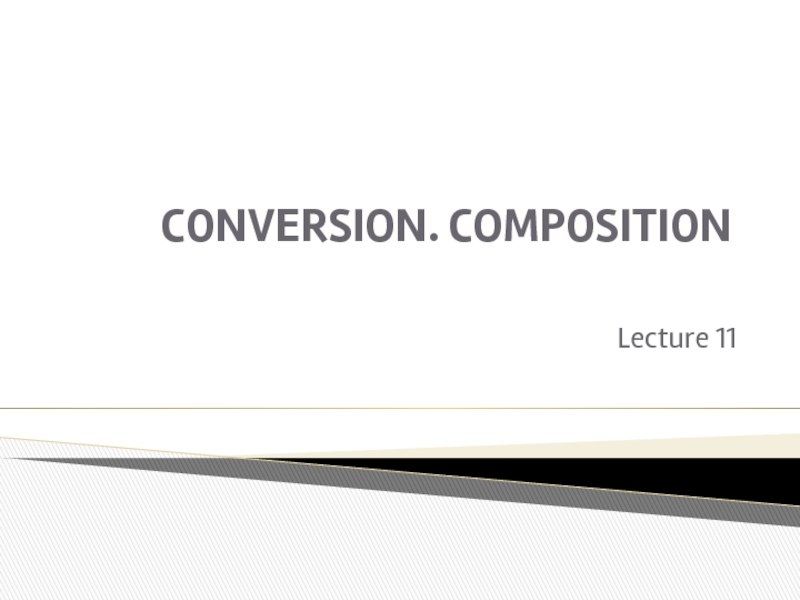
Слайд 2Conversion is the way of forming words, which consists in making
a new word from some existing word by changing the category of a part of speech.
The morphemic shape of the original word remains unchanged: love — to love; paper — to paper; brief — to brief, work — to work; etc.
The new word acquires a meaning, which differs from that of the original one though it can be easily associated with it.
The converted word acquires a new paradigm and a new syntactic function (or functions), which are peculiar to its new category as a part of speech, e.g. plant – to plant.
1. CONVERSION. VARIETIES OF CONVERSION
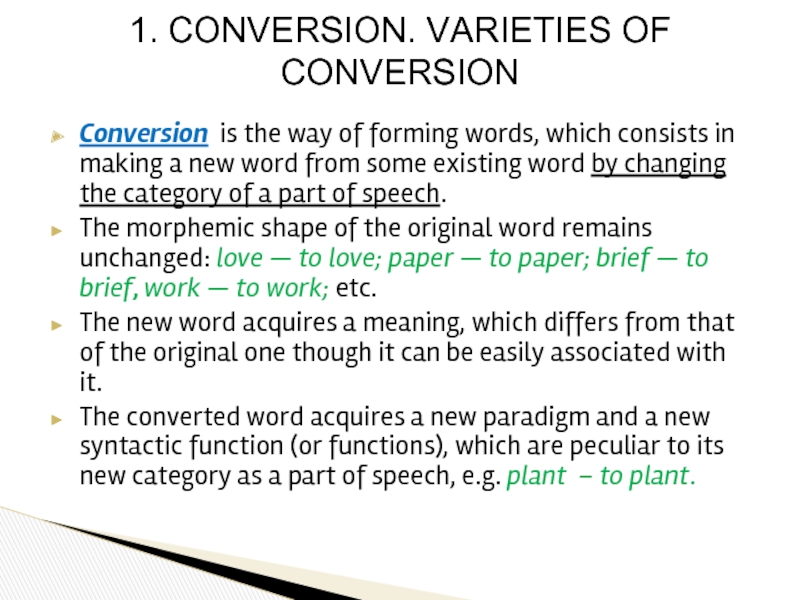
Слайд 3
Meaning, paradigm and functions of plant (n) – plant (v)
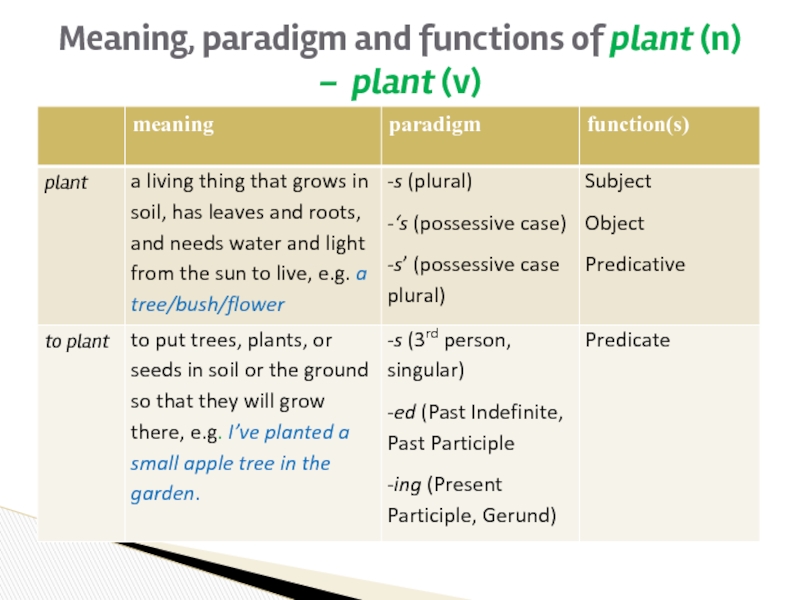
Слайд 4verbalization (the formation of verbs), e.g. to ape (from ape (n));
substantivation
(the formation of nouns), e.g. a private (from private adj.);
adjectivation (the formation of adjectives), e.g. down (adj) (from down (adv));
adverbalization (the formation of adverbs), e.g. home (adv) (from home (n)).
Among the main varieties of conversion are:
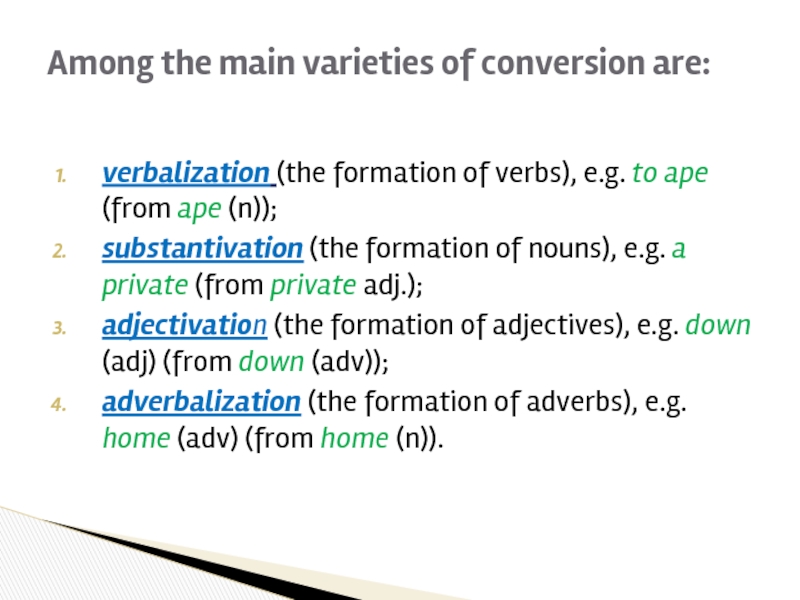
Слайд 5Conversion pairs are distinguished by the structural identity of the root
and phonetic identity of the stem of each of the two words. Synchronically we deal with pairs of words related through conversion that coexist in contemporary English, e.g.
to break — a break — phonetically identical, but do they have the same or identical stems?
2. Synchronic Approach
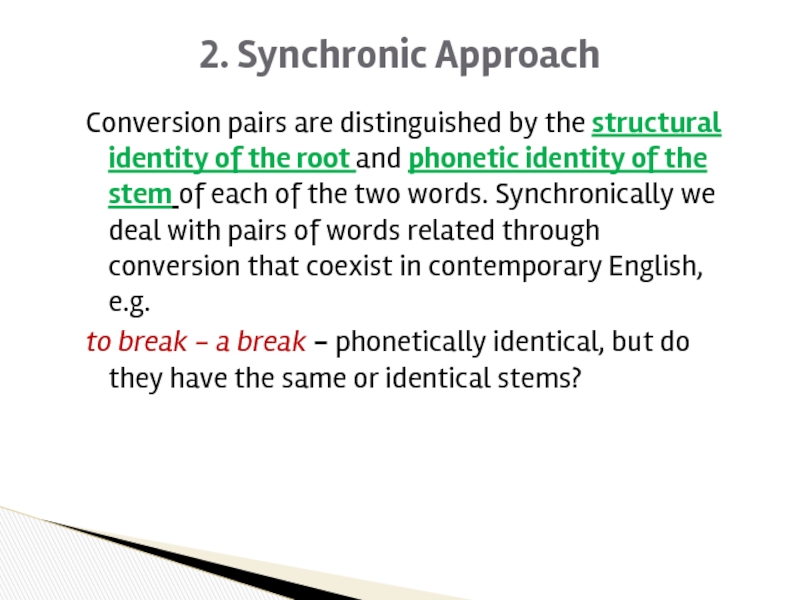
Слайд 6to dress — dress — dresser — dressing — dressy, the
stem dresser — carries not only the lexical meaning of the root-morpheme dress-, but also the meaning of substantivity, the stem dressy- the meaning of quality, etc.
the lexical meaning of the root-morpheme and the part-of-speech meaning of the stem — form part of the meaning of the whole word.
It is the stem that requires a definite paradigm; e.g. the word dresser is a noun primarily because it has a noun-stem and not only because of the noun paradigm;
Within the word-cluster:
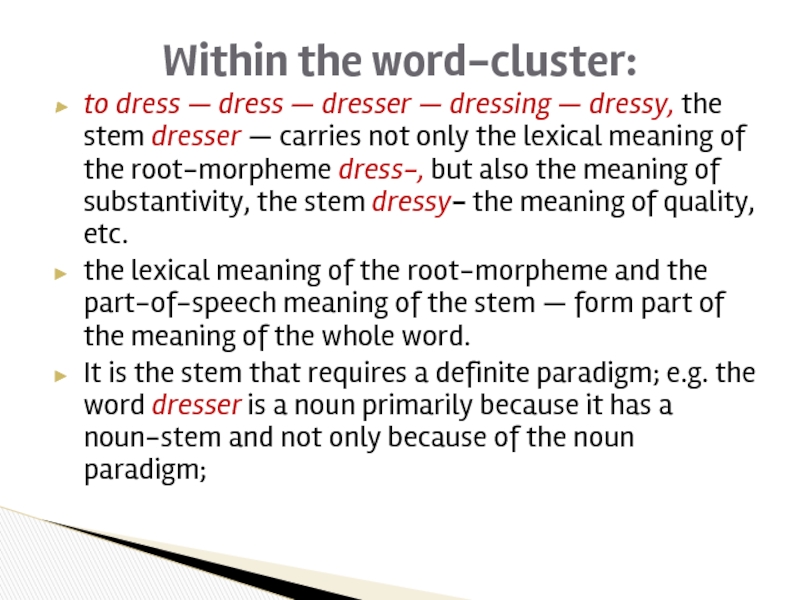
Слайд 7E.g. atom is a noun because of the substantival character of
the stem requiring the noun paradigm;
E.g. sell is a verb because of the verbal character of its stem requiring the verb paradigm, etc.
What is true of words whose root and stem do not coincide is also true of words with roots and stems that coincide:
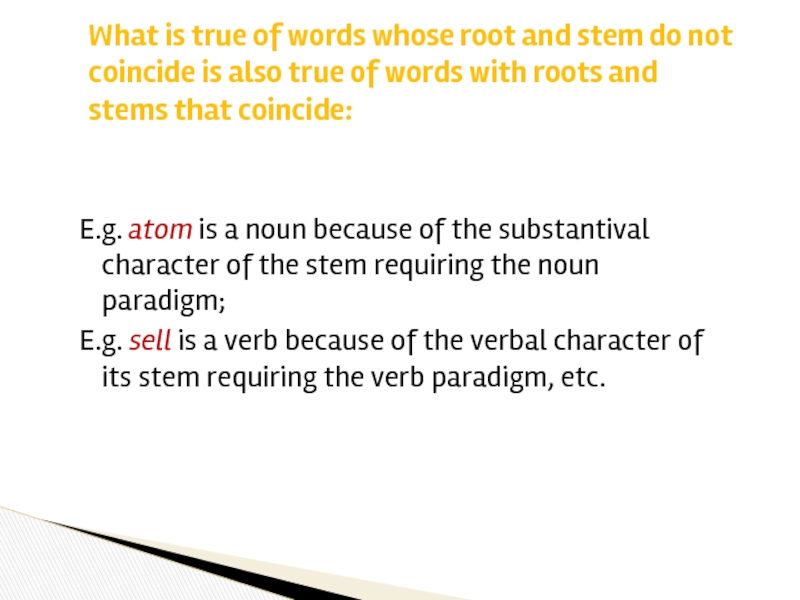
Слайд 8The stem hand- of the noun hand, e.g.carries a substantival meaning
together with the system of its meanings, such as:
the end of the arm beyond the wrist;
pointer on a watch or clock;
worker in a factory;
source of information, etc.;
The stem hand- of the verb hand has a different part-of-speech meaning, namely that of the verb, and a different system of meanings:
give or help with the hand,
pass, etc.
The stems of word-pairs related through conversion have different part-of-speech and denotational meanings.
The stems of two words making up a conversion pair cannot be regarded as being the same or identical
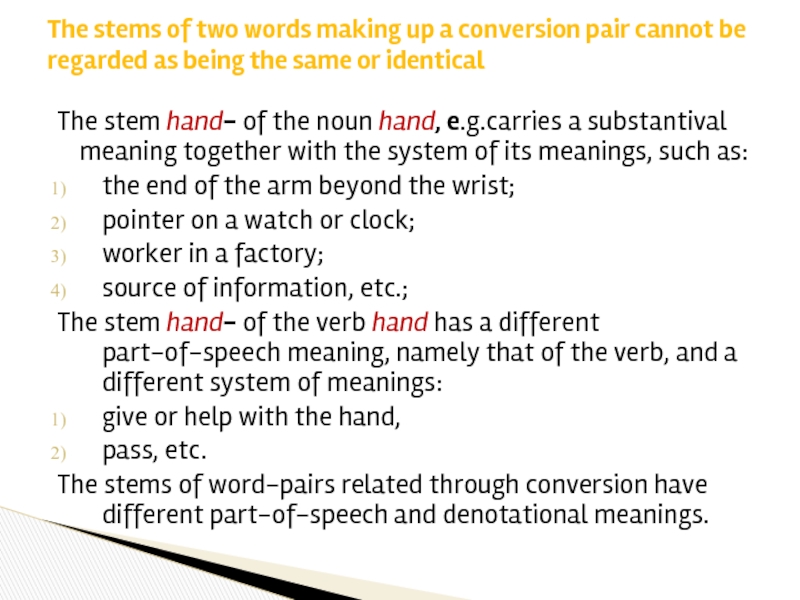
Слайд 9The lexical meaning of the root-morpheme of the noun hand corresponds
to the part-of-speech meaning of its stem: they are both of a substantival character
The lexical meaning of the root-morpheme of the verb hand, however, does not correspond to the part-of-speech meaning of the stem: the root-morpheme denotes an object, whereas the part-of-speech meaning of the stem is that of a process.
The lexical meaning of the root-morpheme and the part-of-speech meaning of the stem within a conversion pair do not correspond:
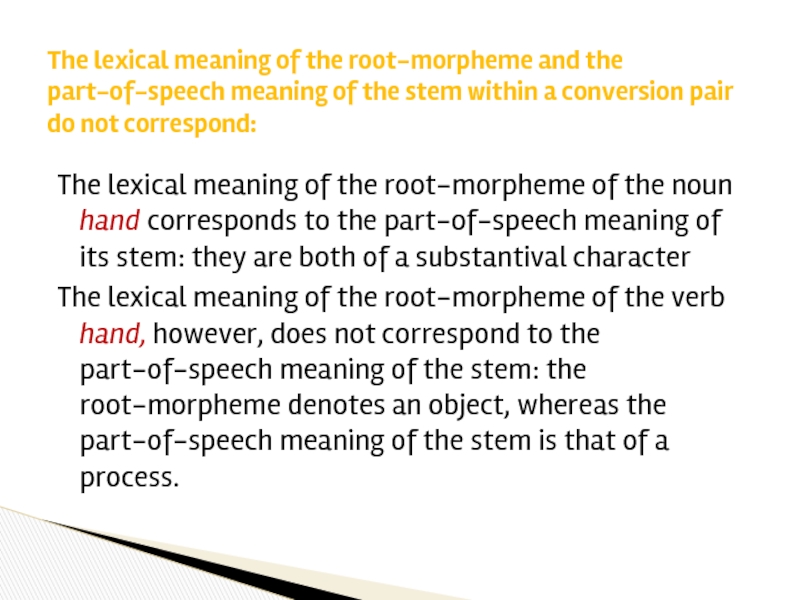
Слайд 10E.g. the part-of-speech meaning of the stem blackness — is that
of substantivity, whereas the root-morpheme black- denotes a quality.
The part-of-speech meaning of the stem eatable- (that of qualitativeness) does not correspond to the lexical meaning of the root-morpheme denoting a process.
In simple words the lexical meaning of the root corresponds to the part-of-speech meaning of the stem, cf. the two types of meaning of simple words like black (a), eat (v), chair (n), etc.
The same kind of non-correspondence is typical of the derived word in general.
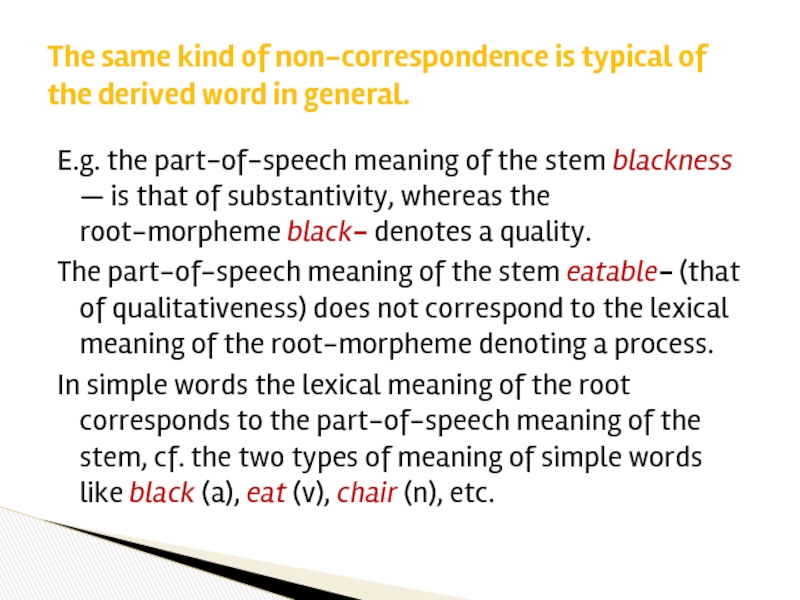
Слайд 11It is natural to regard the stem of one of the
two words making up a conversion pair as being of a derivational character as well.
The essential difference between affixation and conversion is that affixation is characterised by both semantic and structural derivation, e.g. friend — friendless, dark — darkness, etc.), whereas conversion displays only semantic derivation, i.e. hand — to hand, fall — to fall, taxi — to taxi, etc.;
The difference between the two classes of words in affixation is marked both by a special derivational affix and a paradigm, whereas in conversion it is marked only by paradigmatic forms.
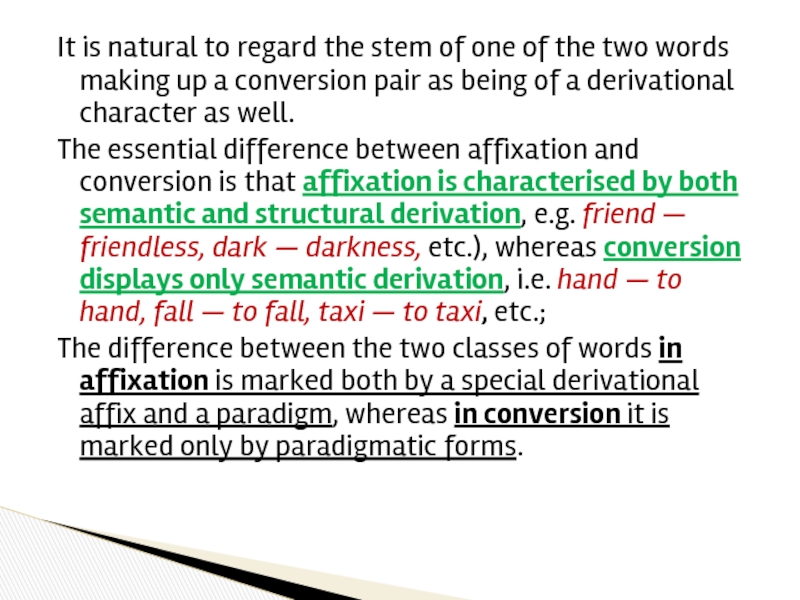
Слайд 12I. Verbs converted from nouns are called denominal verbs. If the
noun refers to some object of reality (both animate and inanimate) the converted verb may denote:
action characteristic of the object: ape (n) — ape (v) — ‘imitate in a foolish way’;
instrumental use of the object: screw (n) − screw (v) − ‘fasten with a screw’;
acquisition or addition of the object: fish (n) — fish (v) − ‘catch or try to catch fish’;
deprivation of the object: dust (n) − dust (v) − ‘remove dust from something, etc.
location: garage (n) – garage (v) ‘to put a car in a garage’
3. TYPICAL SEMANTIC RELATIONS
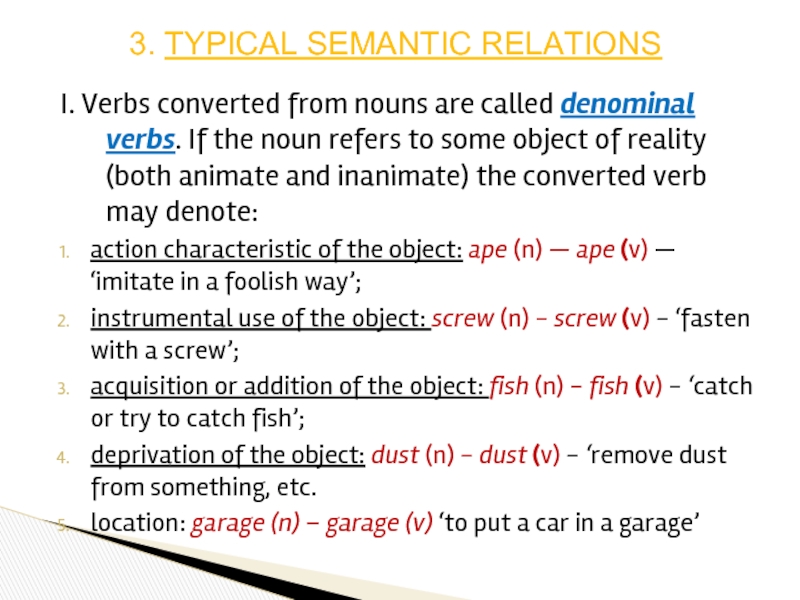
Слайд 132. Nouns converted from verbs are called deverbal substantives. The verb
generally referring to an action, the converted noun may denote:
instance of the action, e.g. jump (v) — jump (n) — ’sudden spring from the ground’;
agent of the action, e.g. help (v) − help (n) − ‘a person who helps’; it is of interest to mention that the deverbal personal nouns denoting the doer are mostly derogatory, e.g. bore (v) − bore (n) − ‘a person that bores’;
place of the action, e.g. drive(v) − drive (n) − ‘a path or road along which one drives’;
object or result of the action, e.g. peel (v) − peel (n) − ‘the outer skin of fruit or potatoes taken off; etc.
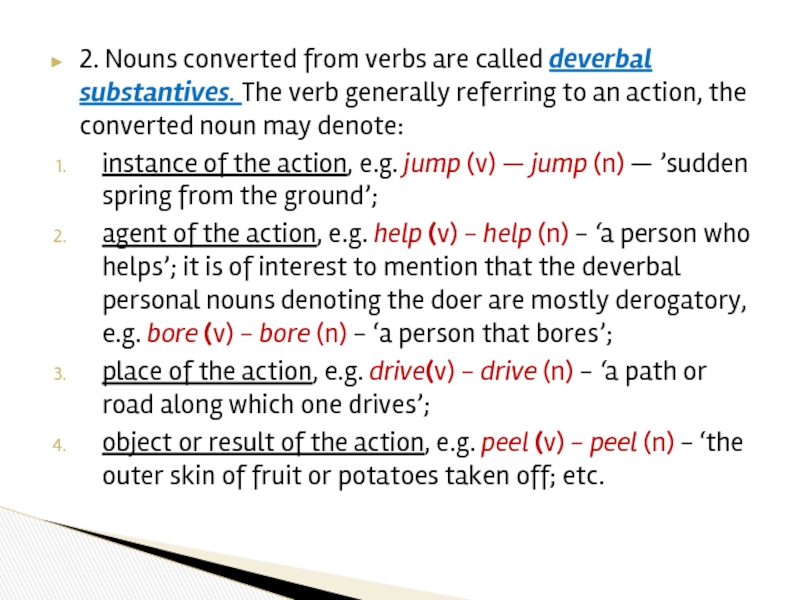
Слайд 14The criterion of non-correspondence between the lexical meaning of the root-morpheme
and the part-of-speech meaning of the stem in one of the two words is a conversion pair: pen n — pen v, father n — father v, etc. the noun is the name for a being or a concrete thing. The lexical meaning of the root-morpheme corresponds to the part-of-speech meaning of the stem.
There are a great many conversion pairs in which it is extremely difficult to exactly determine the semantic character of the root-morpheme, e.g. answer v — answer n; match v — match n, etc.
4. CRITERIA OF SEMANTIC DERIVATION IN CONVERSION
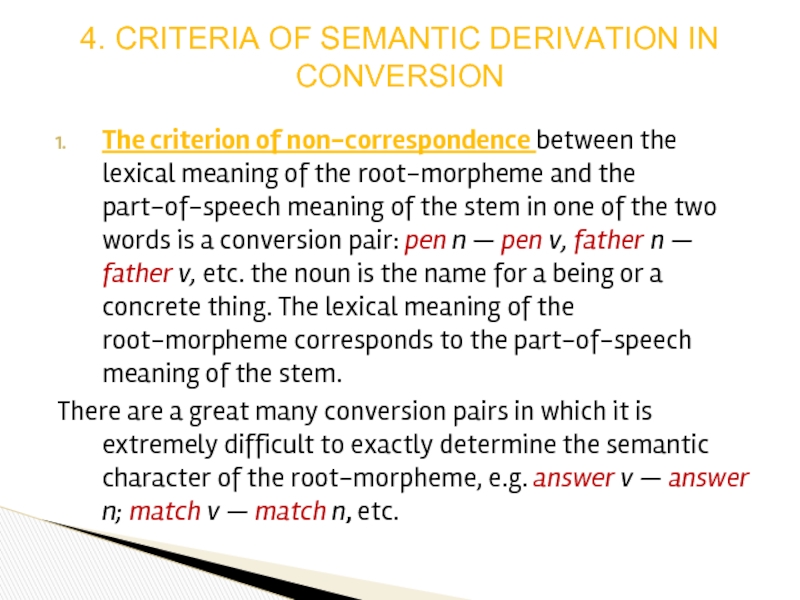
Слайд 15involves a comparison of a conversion pair with analogous word-pairs making
use of the synonymic sets, of which the words in question are members, e.g. chat v — chat n; show v — show n, etc. with analogous synonymic word-pairs like converse — conversation; exhibit — exhibition; occupy — occupation, etc.
It becomes obvious that the nouns chat, show, etc. are the derived members.
The semantic relations in the case of chat v — chat n; show v — show n are similar to those between converse — conversation; exhibit — exhibition.
The synonymy criterion is considerably restricted in its application, it may be applied only to deverbal substantives (v > n).
2. The synonymity criterion
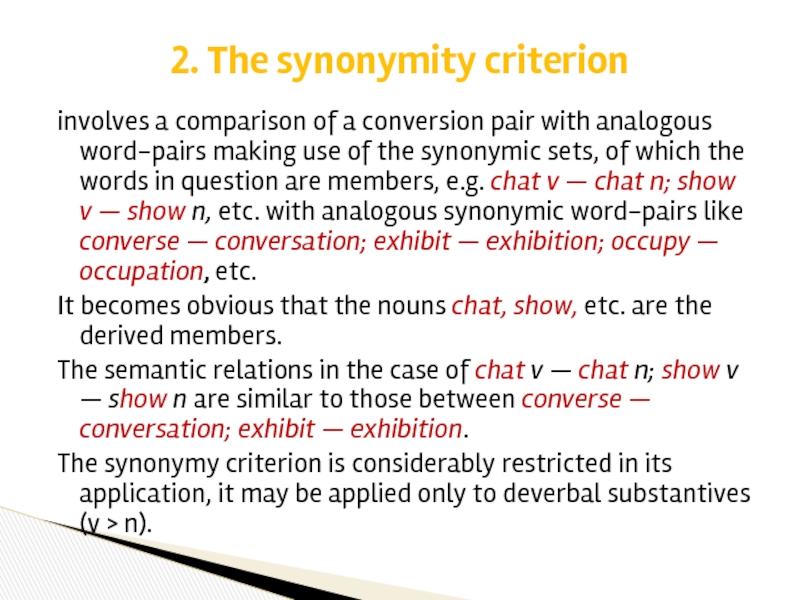
Слайд 16is based on derivational relations within the word-cluster of which the
converted words in question are members.
If the centre of the cluster is a verb, all derived words of the first degree of derivation have suffixes generally added to a verb-base. The centre of a cluster being a noun, all the first-degree derivatives have suffixes generally added to a noun-base.
In the word-cluster hand n — hand v — handful — handy — handed the derived words have suffixes added to the noun-base which makes it possible to conclude that the structural and semantic centre of the whole cluster is the noun hand.
Consequently, the verb hand is semantically derived from the noun hand.
3. THE CRITERION OF DERIVATIONAL RELATIONS

Слайд 17is based on semantic relations within conversion pair.
The existence of
relations typical of denominal verbs within a conversion pair proves that the verb is the derived member, the existence of relations typical of deverbal substantive marks the noun as the derived member.
E.g., the semantic relations between crowd (n) – crowd (v) are perceived as those of ‘an object and an action characteristic of the object’. This fact makes it possible to conclude that the verb crowd is the derived member.
4. The criterion of semantic derivation
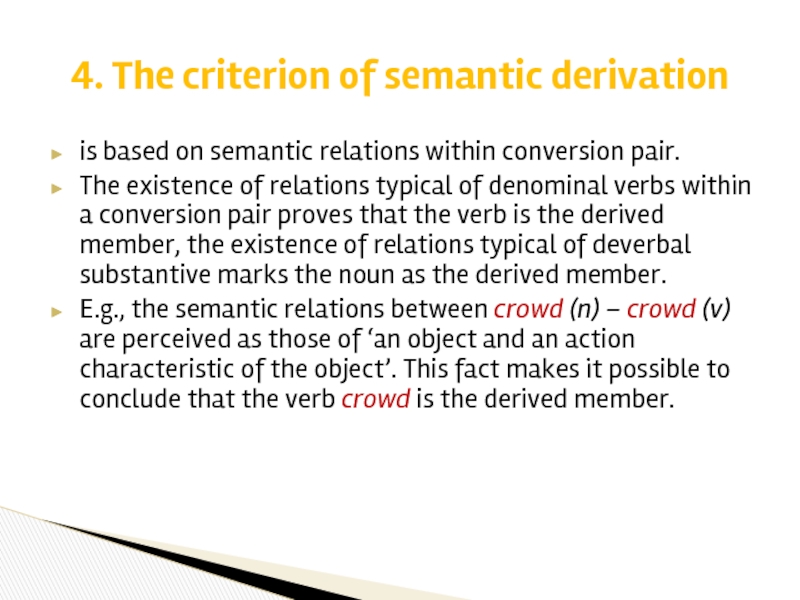
Слайд 18According to this frequency criterion a lower frequency value testifies to
the derived character of the word in question.
According to M. West’s A General Service List of English Words, the frequency value of following verb-noun conversion pairs in correlative meanings taken at random is estimated as follows:
to answer (V = 63%) — answer (N =35%), to help (V = 61%) — help (N = 1%), to joke (V=8%) — joke (N=82%).
By the frequency criterion of semantic derivation in the first two pairs the nouns (answer and help) are derived words (deverbal substantives), in the other pair the verb (to joke) is converted from nouns (denominal verbs).
5. THE CRITERION OF THE FREQUENCY OF OCCURRENCE
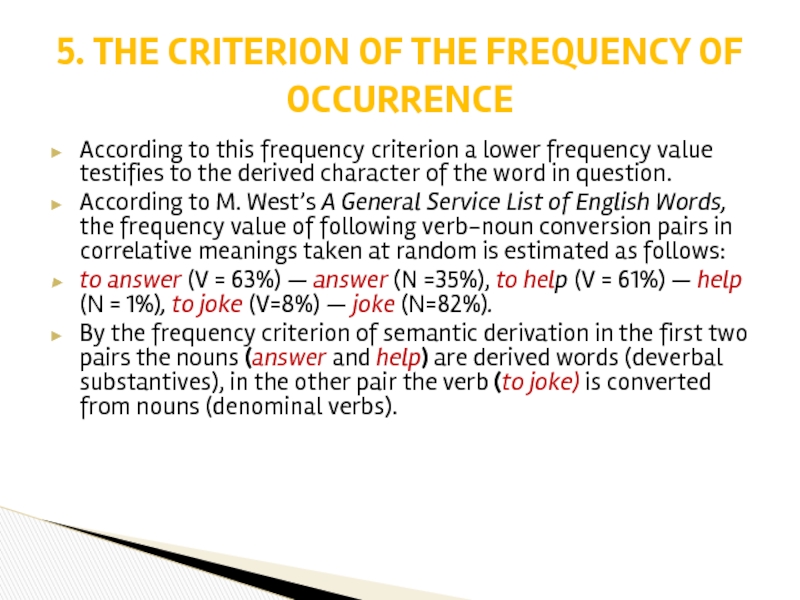
Слайд 19The procedure of the transformational criterion helps to determine the direction
of semantic derivation in conversion pairs.
By analogy with the transformation of predicative syntagmas like The committee elected John into the nominal syntagma John’s election by the committee or the committee’s election of John in which the derivational relationship of elect and election is that of a derived word (election) to its base (elect).
The possibility of transformations like Roy loves nature -> Roy’s love of nature proves the derived character of the noun love.
Nouns cannot be regarded as derived from the corresponding verb base, e.g.
She bosses the establishment -> her boss of the establishment.
I skinned the rabbit -> my skin of the rabbit.
6. THE TRANSFORMATIONAL CRITERION
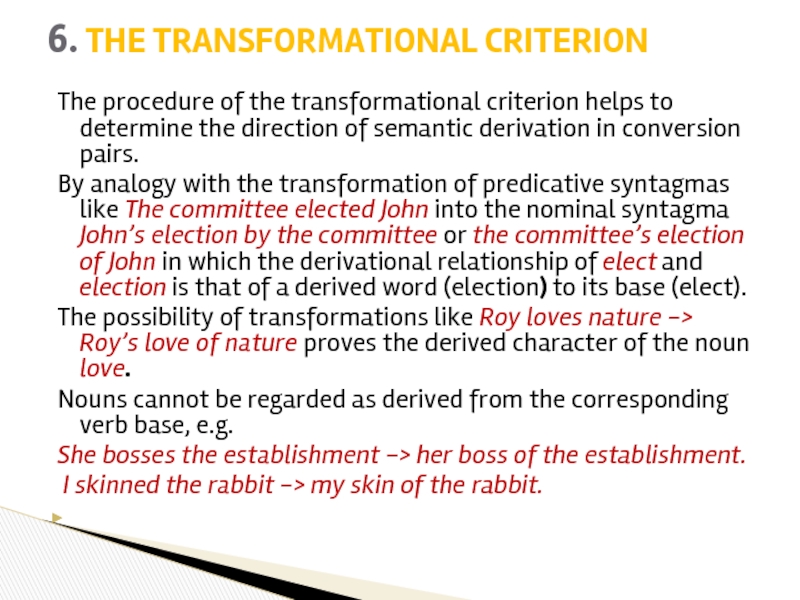
Слайд 20A diachronic survey of the present-day stock of conversion pairs reveals,
that not all of them have been created on the semantic patterns just referred to. Some of them arose as a result of the disappearance of inflections in the course of the historical development of the English language due to which two words of different parts of speech, e.g. a verb and a noun, coincided in pronunciation, e.g.
love n (OE. lufu) — love v (OE. lufian);
work n (OE. wēōrc) — work v (OE. wyrcan);
answer n (OE. andswaru) — answer v (OE. Andswarian).
5. Diachronic Approach
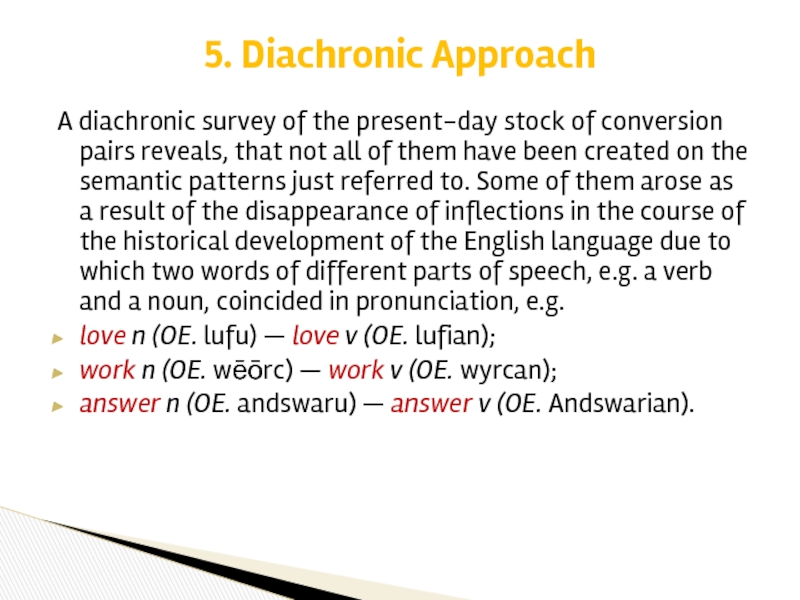
Слайд 21to motor — ‘travel by car’;
to phone — ‘use the
telephone’;
to wire — ’send a telegram’;
to microfilm — ‘produce a microfilm of;
to tear-gas — ‘to use tear-gas’;
to fire-bomb — ‘drop fire-bombs’;
to spearhead — ‘act as a spearhead for’;
to blueprint — ‘work out, outline’
The 20th century new words include a great many verbs formed by conversion:
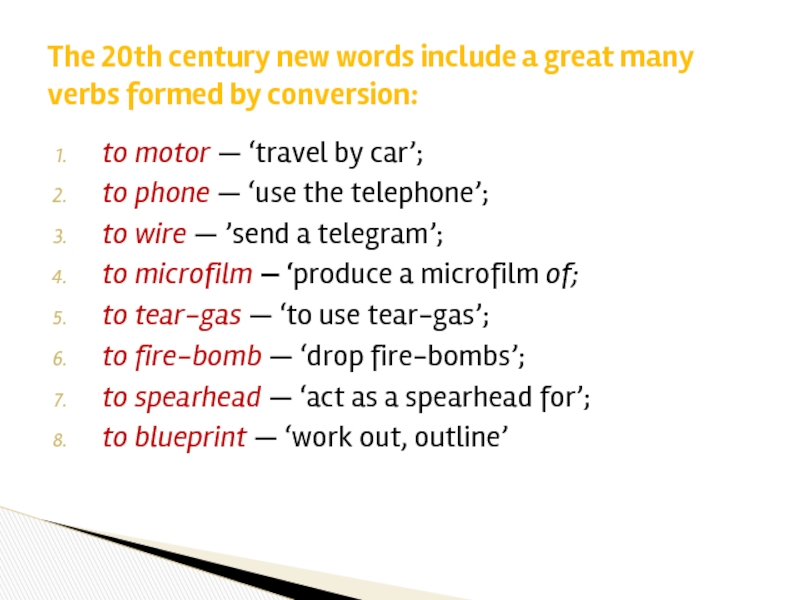
Слайд 22in the course of time the semantic structure of the base
may acquire a new meaning or several meanings under the influence of the meanings of the converted word.
The difference between conversion and reconversion: being a way of forming words conversion leads to a numerical enlargement of the English vocabulary, whereas reconversion only brings about a new meaning correlated with one of the meanings of the converted word.
Reconversion
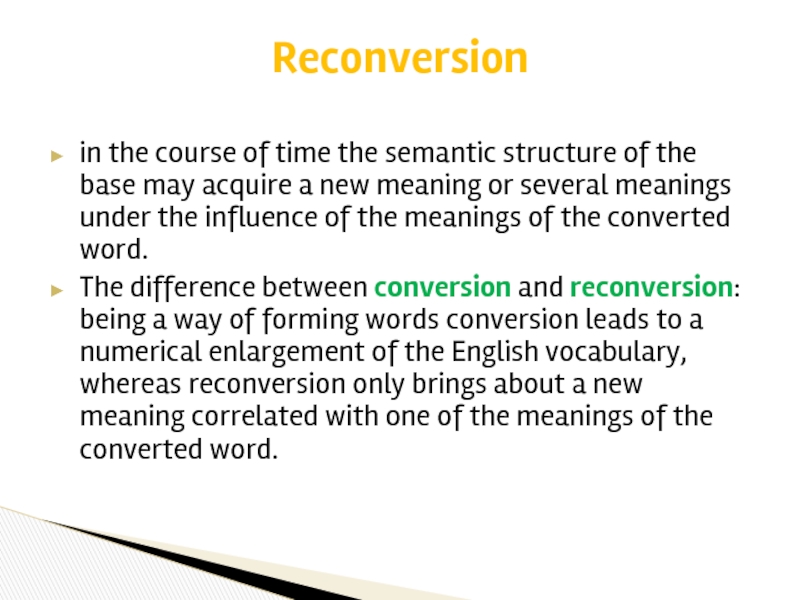
Слайд 23The semantic structure of the base may acquire a new meaning
or several meanings under the influence of the meanings of the converted word. Reconversion only operates with denominal verbs and deverbal nouns
The verb smoke formed in 1000 from the noun smoke in the corresponding meaning had acquired by 1663 another meaning by a metaphorical transfer which, in turn, gave rise to a correlative meaning of the noun smoke in 1715 through reconversion.
Reconversion
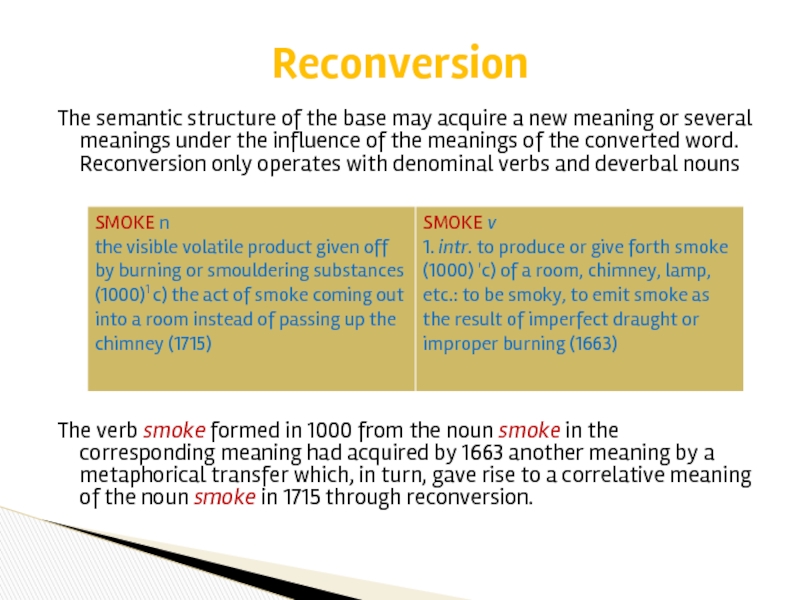
Слайд 24Word-composition (or compounding) is the type of word-formation, in which new
words are produced by combining two or more Immediate Constituents (ICs), which are both derivational bases.
Word-composition is one of the productive types of word-formation in Modern English. Compound words are inseparable vocabulary units. They are formally and semantically dependent on the constituent bases and the semantic relations between them, which mirror the relations between the motivating units.
II. WORD-COMPOSITION
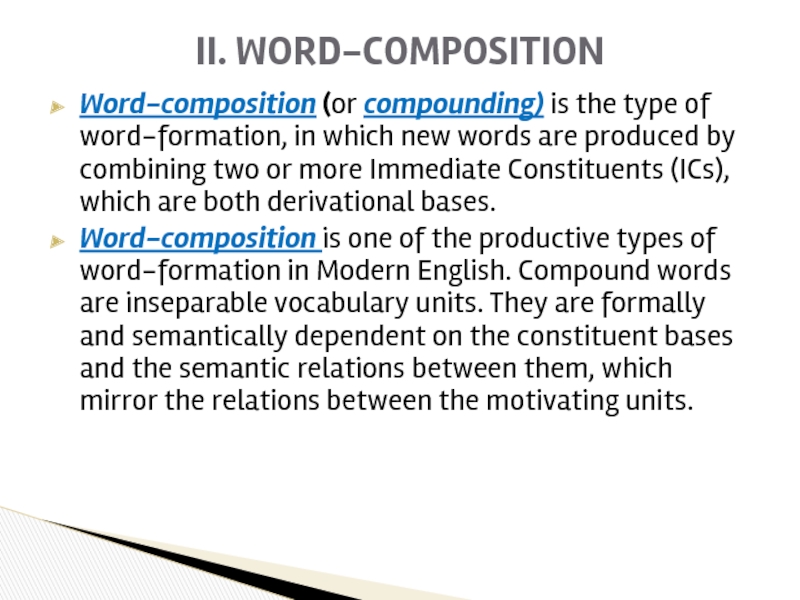
Слайд 25bases that coincide with morphological stems: to day-dream, daydreamer;
bases that coincide
with word-forms, e.g. wind-driven, paper-bound;
bases that coincide with word-groups, e.g. blue-eyed, long-fingered.
The ICs compound words represent bases of three structural types:
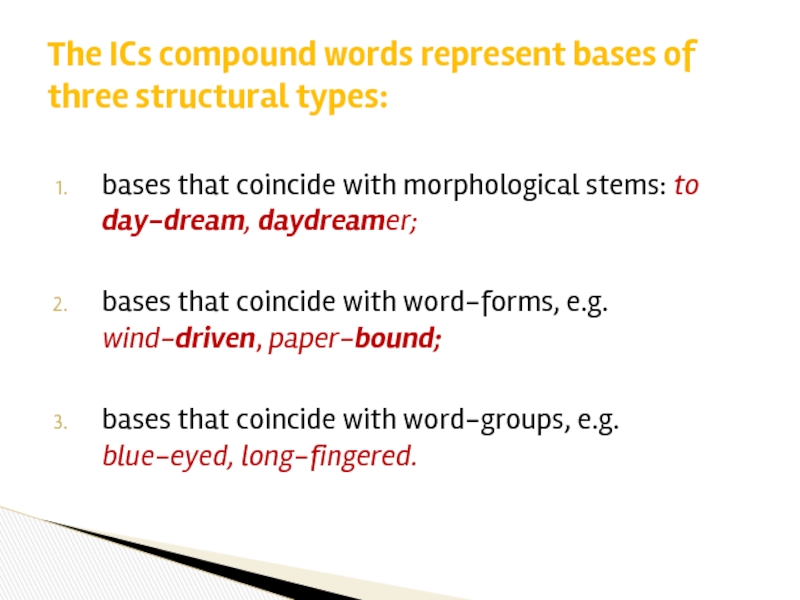
Слайд 26simple, e.g. week-end;
derived, e.g. letter-writer, office-management;
compound, e.g. fancy-dress-maker, aircraft-carrier,
etc. However, this complexity of structure of bases is not typical of the bulk of Modern English compounds.
The bases built on stems may be of different degrees of complexity:
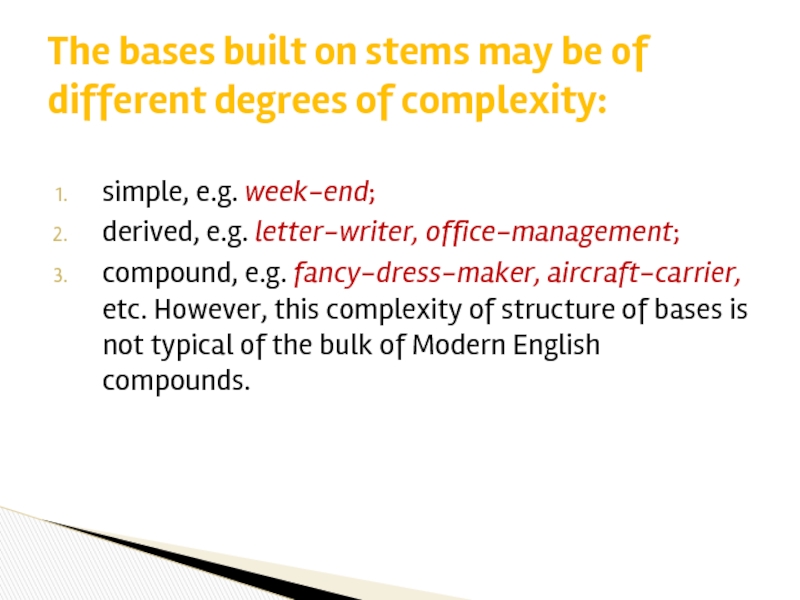
Слайд 27or derivatives built according to an affixal pattern but on a
compound stem for its base such as, e.g.,
school-mastership ([n+n]+suf),
ex-housewife (prf+[n+n]),
to weekend, to spotlight ([n+n]+conversion).
Not to confuse compound words with polymorphic words of secondary derivation
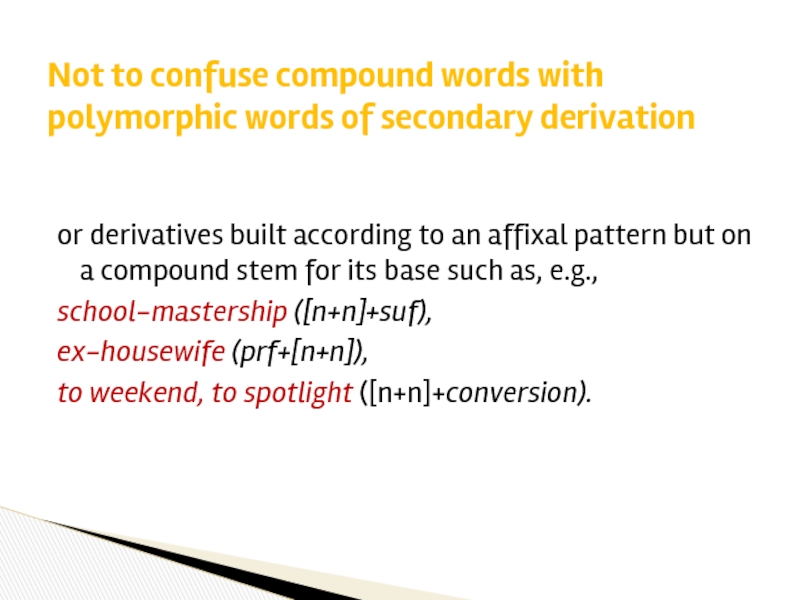
Слайд 28The meaning of a compound word is made up of two
components: structural and lexical.
4.1. THE STRUCTURAL MEANING
The structural meaning of compounds is formed on the base of:
1) the meaning of their distributional pattern;
2) the meaning of their derivational pattern.
4. TYPES OF MEANING OF COMPOUND WORDS
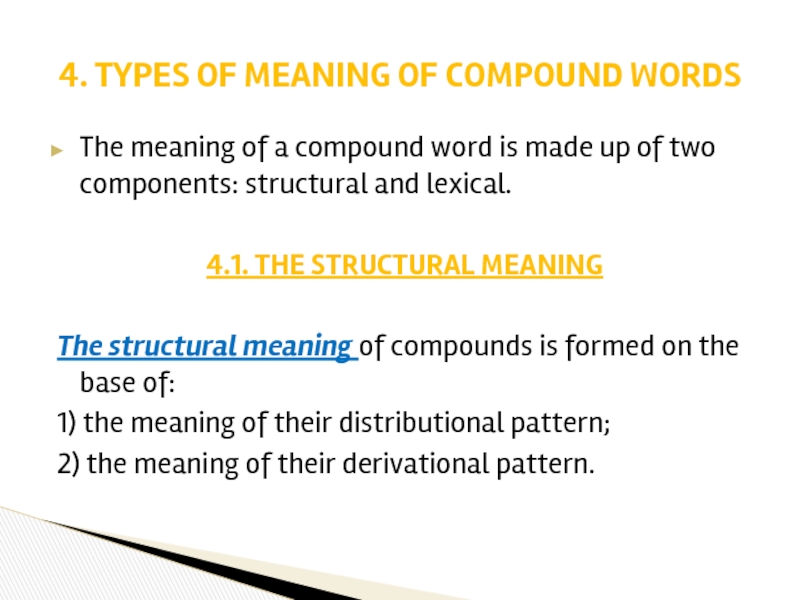
Слайд 29is understood as the order and arrangement of the ICs that
constitute a compound word.
A change in the order and arrangement of the same ICs signals the compound words of different lexical meanings, cf.: pot-flower (‘a flower that grows in a pot’) and flower-pot (‘s small container used for growing flowers in’).
A change in the order arrangement of the ICs that form a compound may destroy its meaning.
Thus, the distributional pattern of a compound carries a certain meaning of its own which is largely independent of the actual lexical meaning of their ICs.
The distributional pattern of a compound
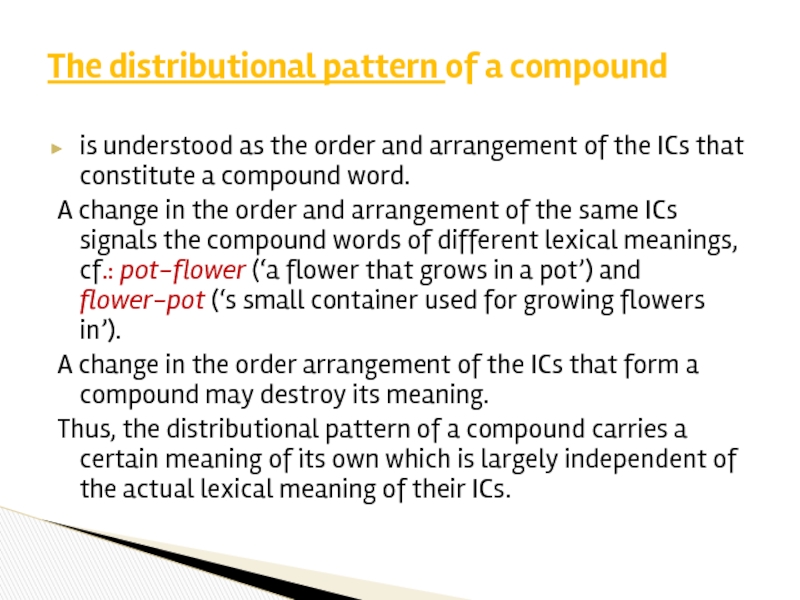
Слайд 30can be abstracted and described through the interrelation of their ICs.
E.g. the derivational pattern n+ven underlying the compound adjectives duty-bound, wind-driven, mud-stained conveys the generalized meaning of instrumental or agentive relations which can be interpreted as ‘done by’ or ‘with the help of something’.
Derivational patterns in compounds may be monosemantic and polysemantic.
E.G. the pattern n+n→N conveys the following semantic relations:
of purpose, e.g. bookshelf;
of resemblance, e.g. needle-fish;
of instrument or agent, e.g. windmill, sunset.
The meaning of the derivational pattern of compounds
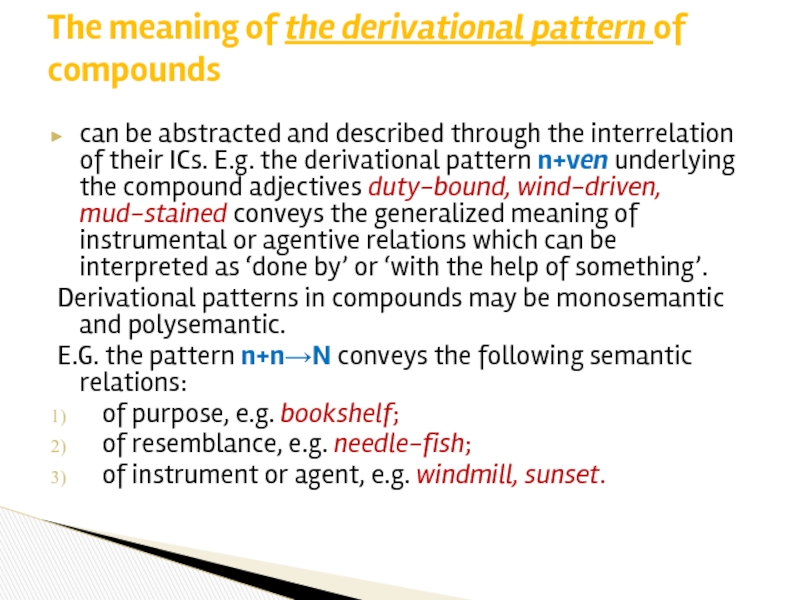
Слайд 31The lexical meaning of compounds is formed on the base of
the combined lexical meanings of their constituents.
The semantic centre of the compound is the lexical meaning of the second component modified and restricted by the meaning of the first.
The lexical meanings of both components are closely fused together to create a new semantic unit with a new meaning, which dominates the individual meanings of the bases, and is characterized by some additional component not found in any of the bases.
E.g. the lexical meaning of the compound word handbag is not essentially ‘a bag designed to be carried in the hand’ but ‘a woman’s small bag to carry everyday personal items’.
THE LEXICAL MEANING
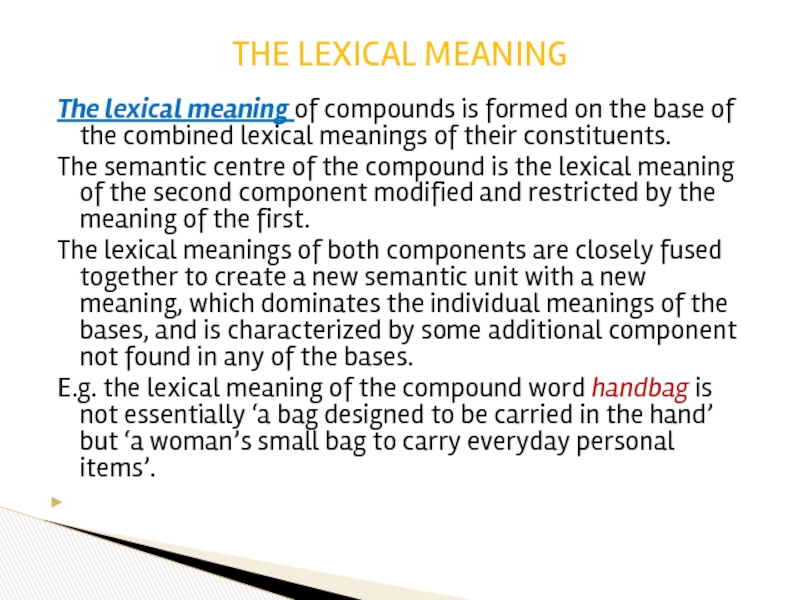
Слайд 32According to the relations between the ICs compound words fall into
coordinative and subordinative compounds.
In coordinative compounds the two ICs are semantically equally important. The coordinative compounds fall into three groups:
reduplicative compounds which are made up by the repetition of the same base, e.g. pooh-pooh, fifty-fifty;
compounds formed by joining the phonically variated rhythmic twin forms, e.g. chit-chat, zig-zag (with the same initial consonants but different vowels); walkie-talkie, clap-trap (with different initial consonants but the same vowels);
additive compounds which are built on stems of the independently functioning words of the same part of speech, e.g. actor-manager, queen-bee.
CLASSIFICATION OF COMPOUND WORDS
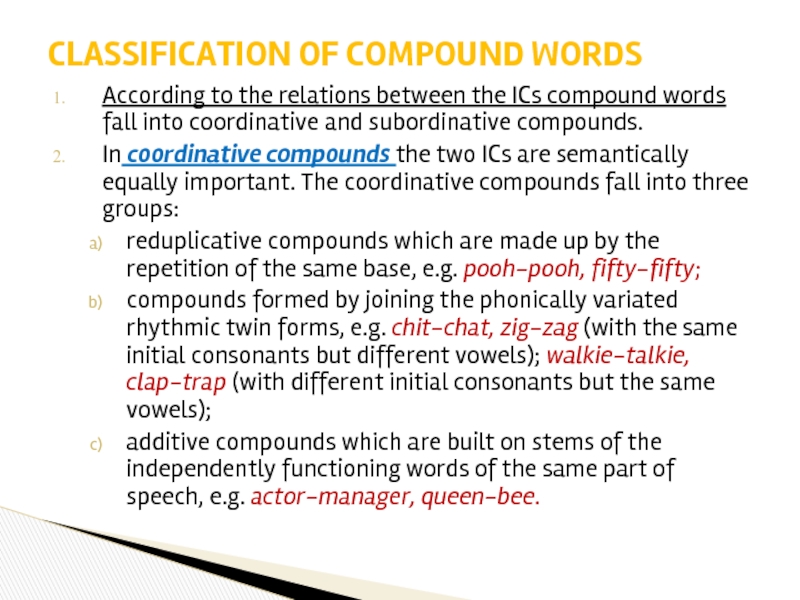
Слайд 33In subordinative compounds the components are neither structurally nor semantically equal
in importance but are based on the domination of the head-member which is, as a rule, the second IC, e.g. stone-deaf, age-long.
The second IC preconditions the part-of-speech meaning of the whole compound.
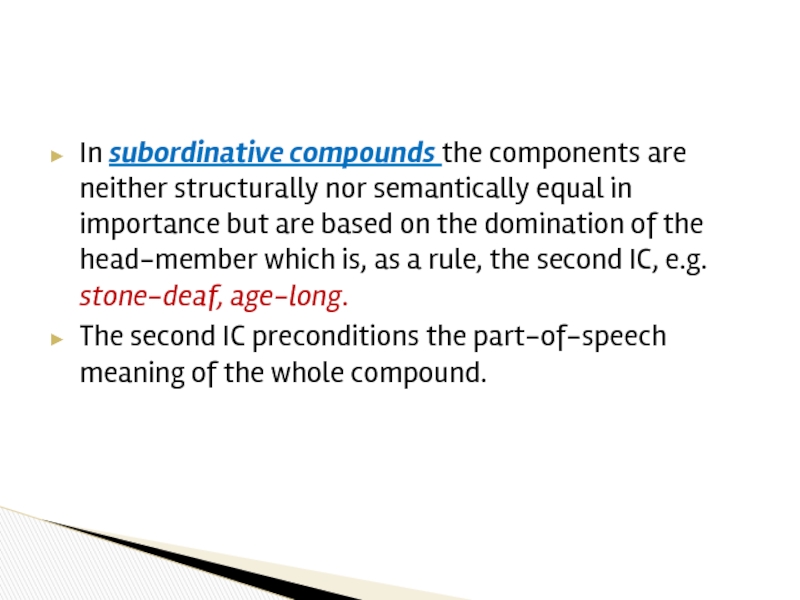
Слайд 34compound nouns, e.g. sunbeam, maidservant;
compound adjectives, e.g. heart-free, far-reaching;
compound pronouns, e.g.
somebody, nothing;
compound adverbs, e.g. nowhere, inside;
compound verbs, e.g. to offset, to bypass, to mass-produce.
2. According to the part of speech compounds fall into:
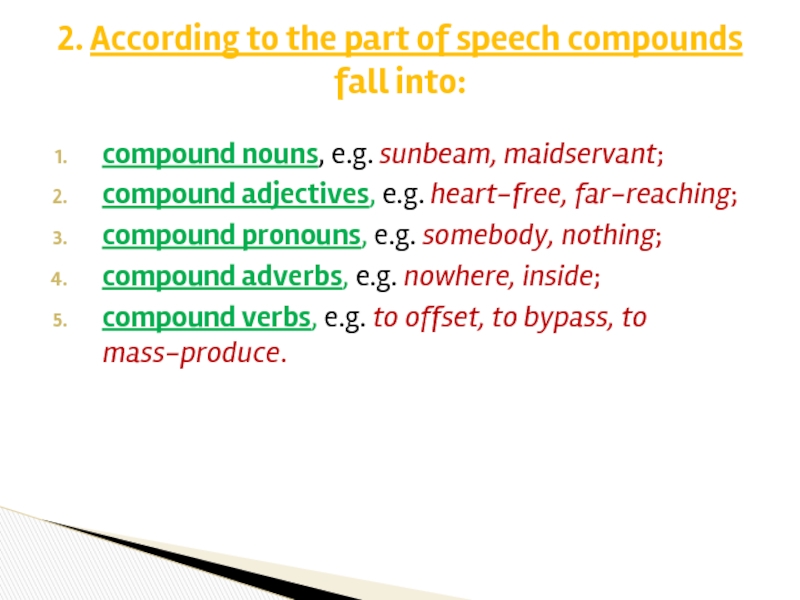
Слайд 35compounds composed without connecting elements, e.g. heartache, dog-house;
compounds composed with
the help of a vowel or a consonant as linking elements, e.g. handicraft, speedometer, statesman;
compounds composed with the help of linking elements represented by preposition or conjunction stems, e.g. son-in-law, pepper-and-salt.
3. According to the means of composition compound words are classified into:
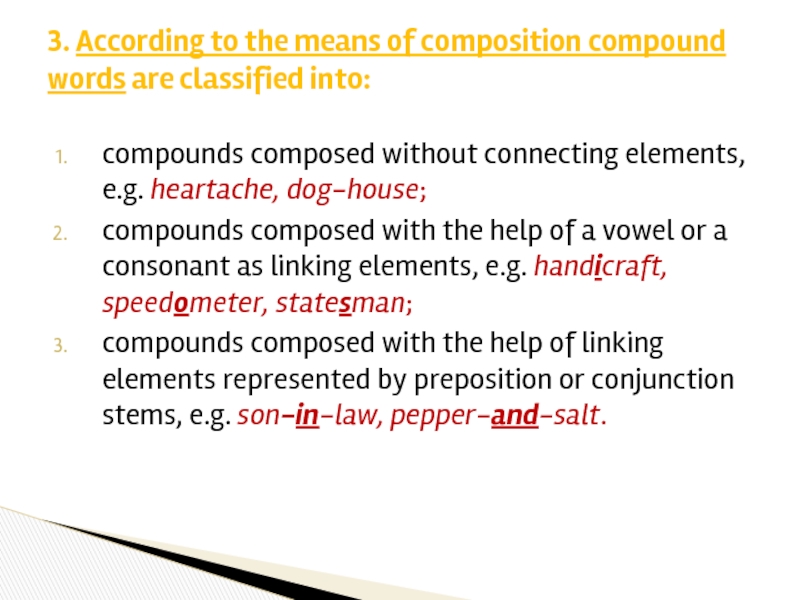
Слайд 36compounds proper that are formed by joining together bases built on
the stems or on the word-forms with or without a linking element, e.g. door-step, street-fighting;
derivational compounds that are formed by joining affixes to the bases built on the word-groups or by converting the bases built on the word-groups into other parts of speech, long-legged → (long legs) + -ed; a turnkey → (to turn key) + conversion.
4. According to the type of bases that form compounds the following classes can be singled out:
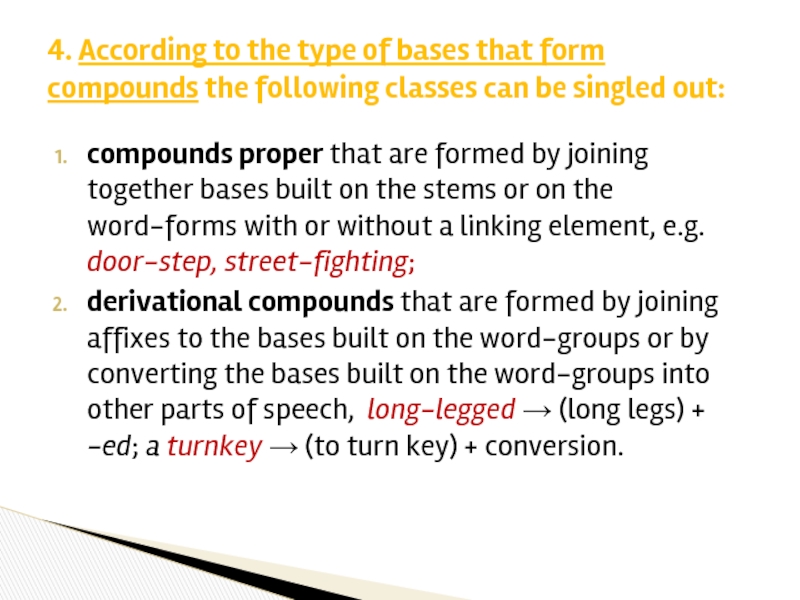
Слайд 37
derivational compounds mainly formed with the help of suffixes –ed and
–er applied to bases built, as a rule, on attributive phrases, e.g. narrow-minded, doll-faced, lefthander;
derivational compounds formed by conversion applied to bases built, as a rule, on three types of phrases – verbal-adverbial phrases (a breakdown), verbal-nominal phrases (a kill-joy) and attributive phrases (a sweet-tooth).
Derivational compounds
fall into two groups:
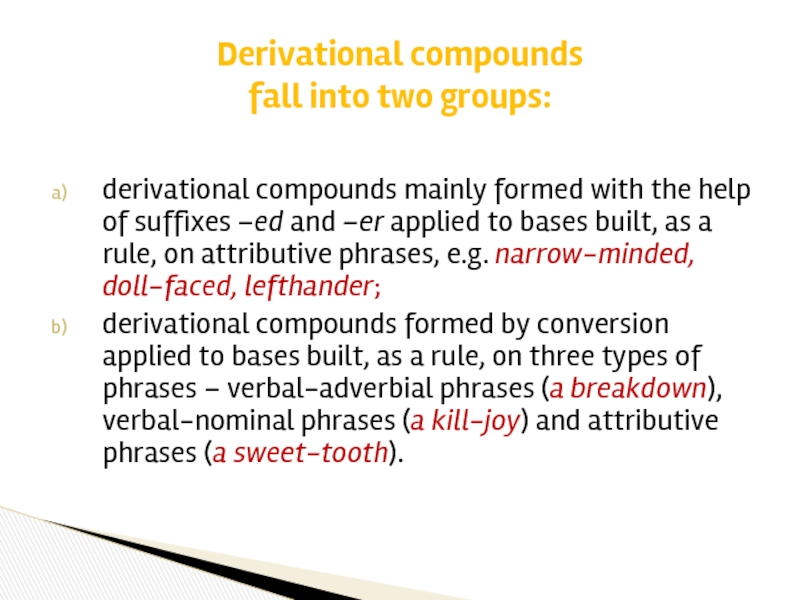
Слайд 38Correlational types of compounds
Correlation embraces both the structure and the meaning
of compound words.
E.g., compound nouns of the pattern n+n (story-teller, watch-maker) reflect the agentive relations proper to free phrases of the N who V+N type (one who tells stories, one who makes watches).
Correlation is a regular interaction and interdependence of compound words and certain types of free phrases, which condition the potential possibility of appearance of compound words, their structure and semantic type.
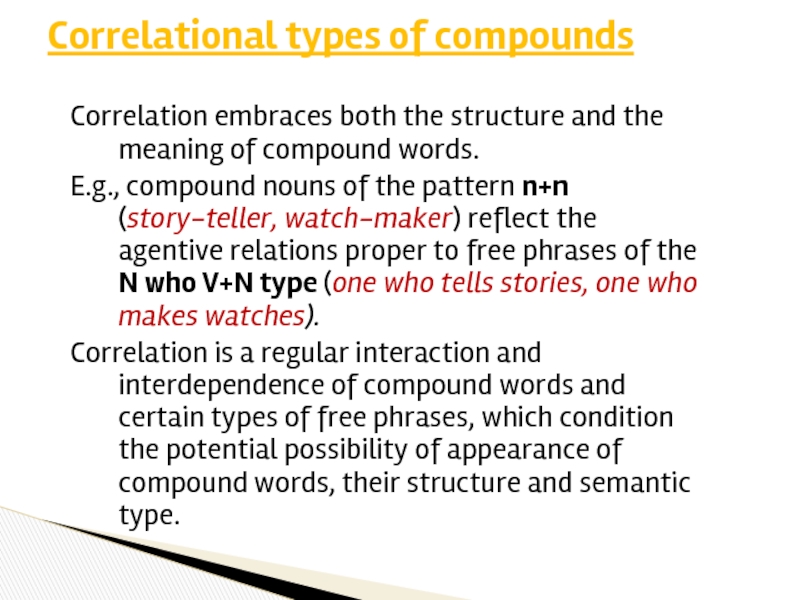
Слайд 39Verbal-nominal;
Nominal;
Adjectival-nominal;
Verbal-adverbial.
The description of compound words through the correlation with variable
free phrases makes it possible to classify them into:
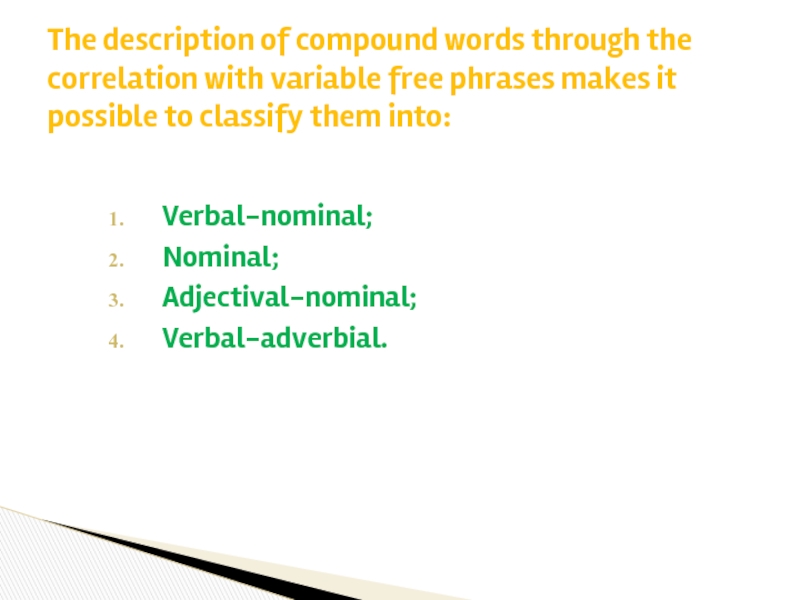
Слайд 44Derivational compound adjectives
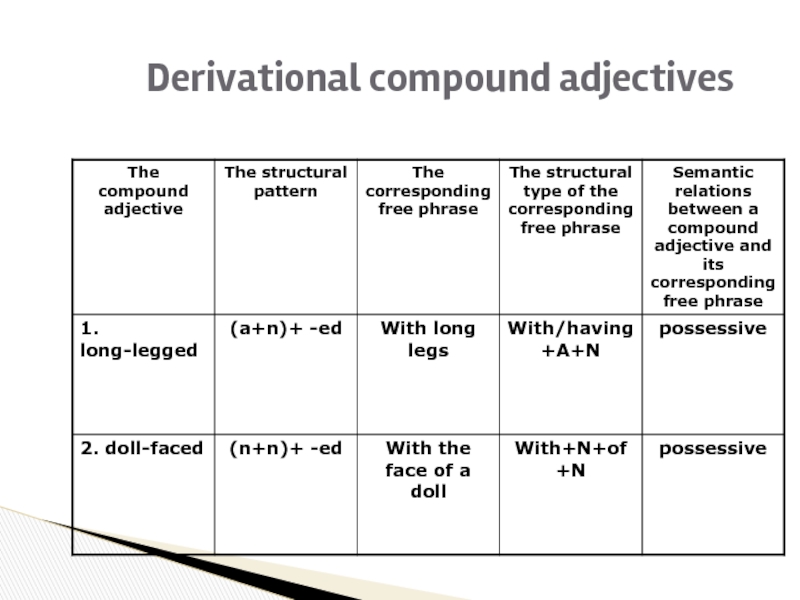
Слайд 45The actual process of building compound words may take different forms:
Compound words as a rule are built spontaneously according to productive distributional formulas of the given period.
Thus at one time the process of building verbs by compounding adverbial and verbal stems was productive, and numerous compound verbs like outgrow, offset, inlay (adv + v), were formed.
The structure ceased to be productive and today practically no verbs are built in this way.
SOURCES OF COMPOUNDS
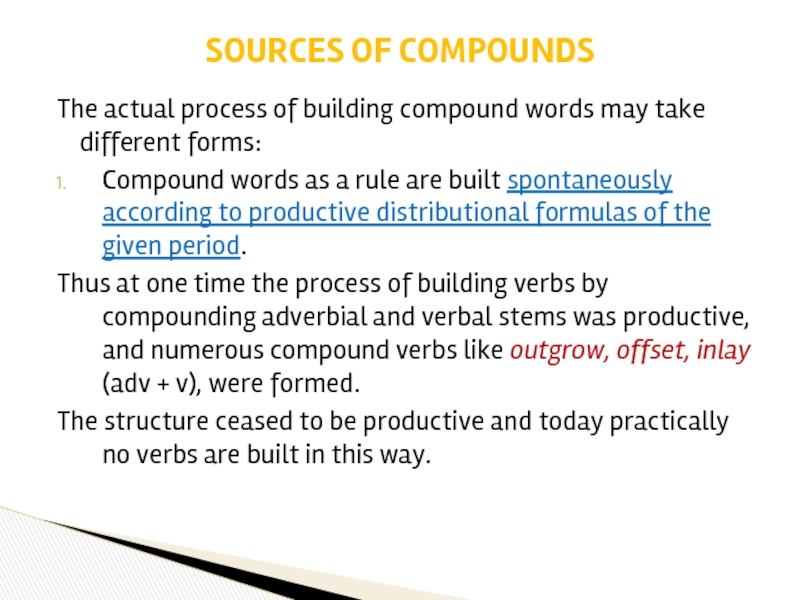
Слайд 46Compounds may be the result of a gradual process of semantic
isolation and structural fusion of free word-groups.
Such compounds as forget-me-not — ‘a small plant with blue flowers’; bull’s-eye — ‘the centre of a target; a kind of hard, globular candy’; mainland — ‘a continent’ all go back to free phrases which became semantically and structurally isolated in the course of time.
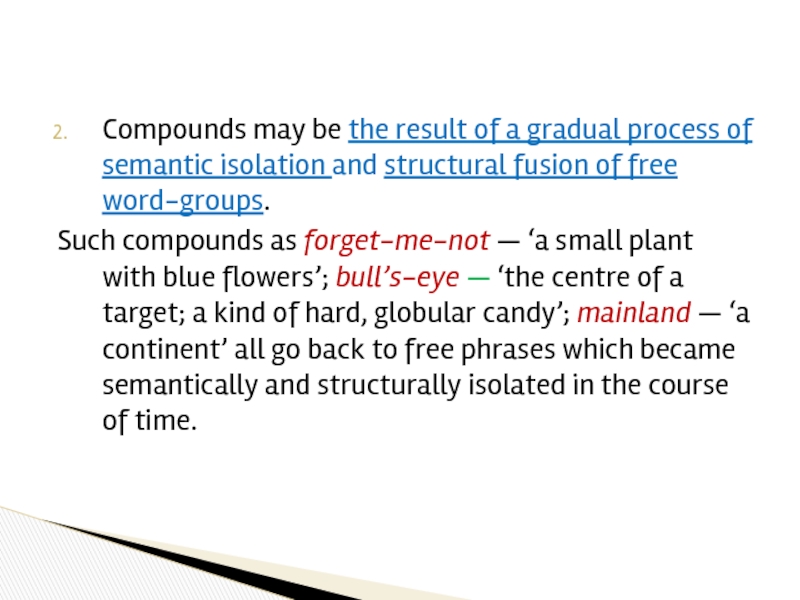
Слайд 47The words that once made up these phrases have lost, within
these particular formations, their integrity, the whole phrase has become isolated in form, specialised in meaning and thus turned into an inseparable unit — a word having acquired semantic and morphological unity.
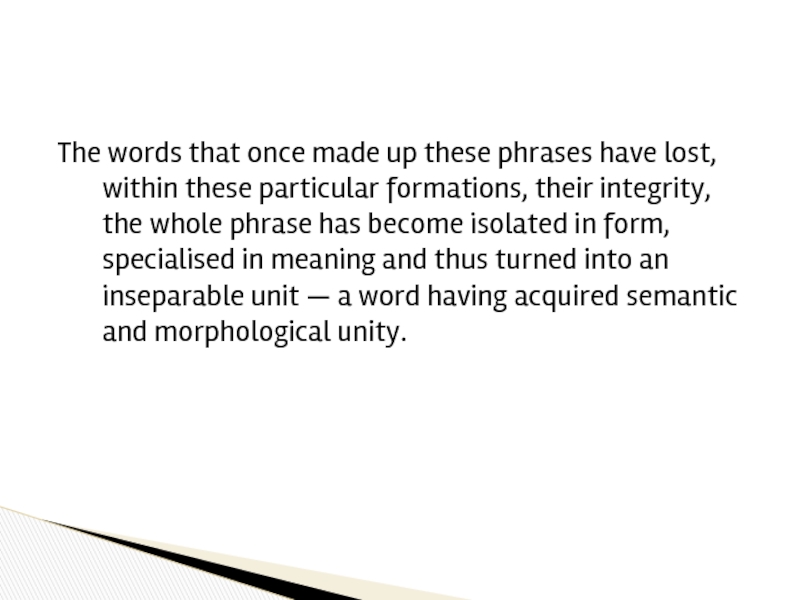
Слайд 48Most of the syntactic compound nouns of the (a+n) structure, e.g.
bluebell, blackboard, mad-doctor, are the result of such semantic and structural isolation of free word-groups. One more example highway was once actually a high way for it was raised above the surrounding countryside for better drainage and ease of travel.
Now we use highway without any idea of the original sense of the first element.
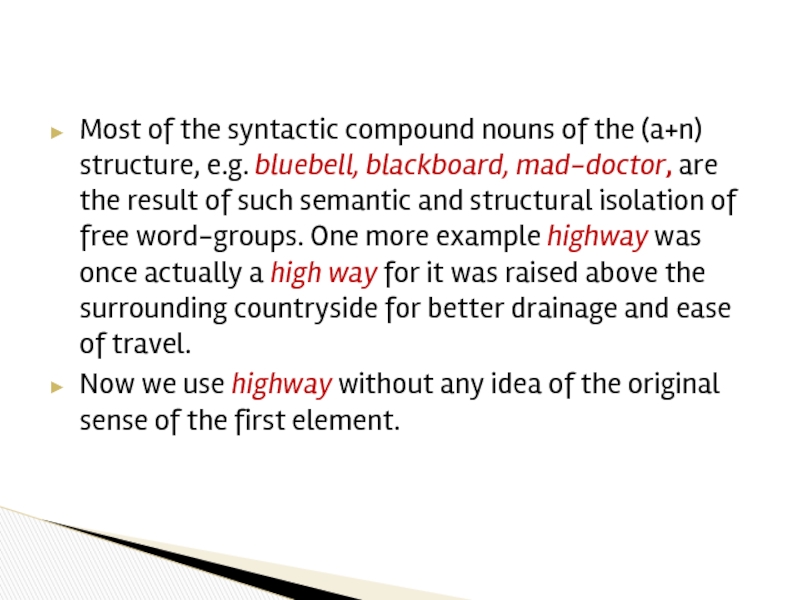
Слайд 49Зыкова И.В. Практический курс английской лексикологии. М.: Академия, 2006. – С.87-93.
Гинзбург Р.З. Лексикология английского языка. М.: Высшая школа, 1979. – С. 127-158.
Антрушина Г.Б., Афанасьева О.В., Морозова Н.Н. Лексикология английского языка. М.: Дрофа, 2006. – С. – 78-128.
References
